Daikin FAQ24TAVJU, FAQ18TAVJU User Manual
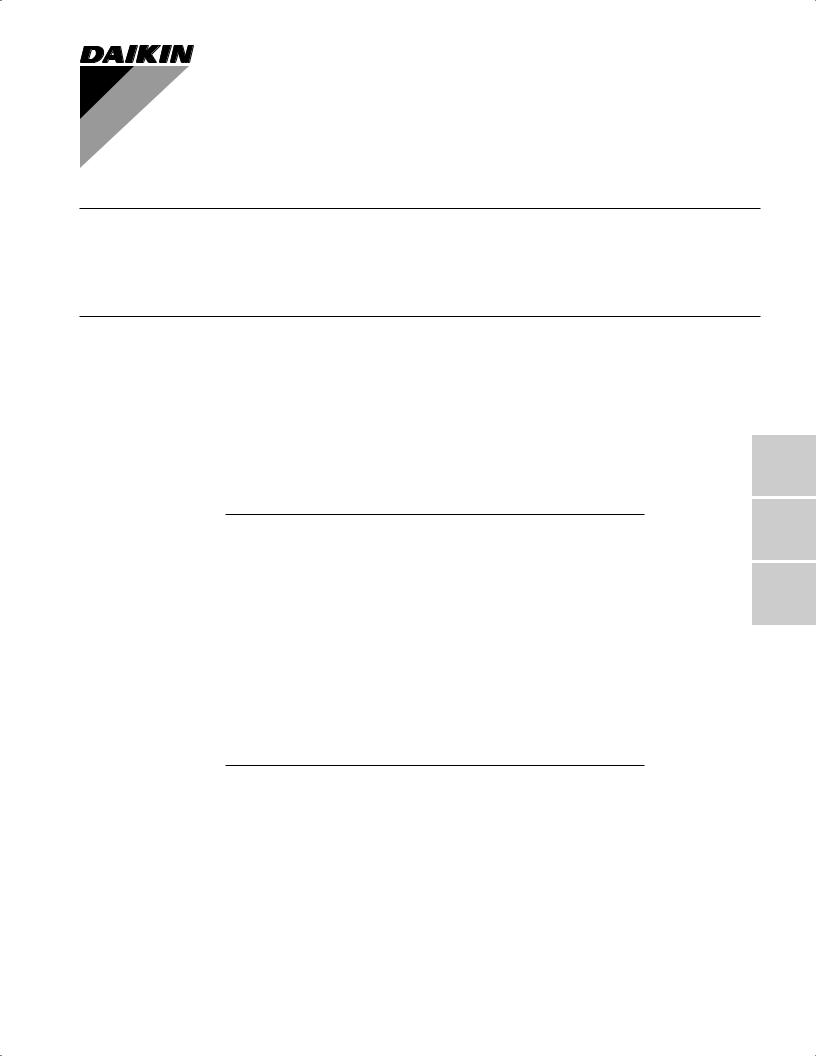
INSTALLATION MANUAL
SPLIT SYSTEM |
Air Conditioners |
MODELS
Wall-mounted type
FAQ18TAVJU
FAQ24TAVJU
Read these instructions carefully before installation.
Keep this manual in a handy place for future reference.
This manual should be left with the equipment owner.
Lire soigneusement ces instructions avant l’installation. Conserver ce manuel à portée de main pour référence ultérieure.
Ce manuel doit être donné au propriétaire de l’équipement.
Lea cuidadosamente estas instrucciones antes de instalar. Guarde este manual en un lugar a mano para leer en caso de tener alguna duda.
Este manual debe permanecer con el propietario del equipo.
English
Français
Español
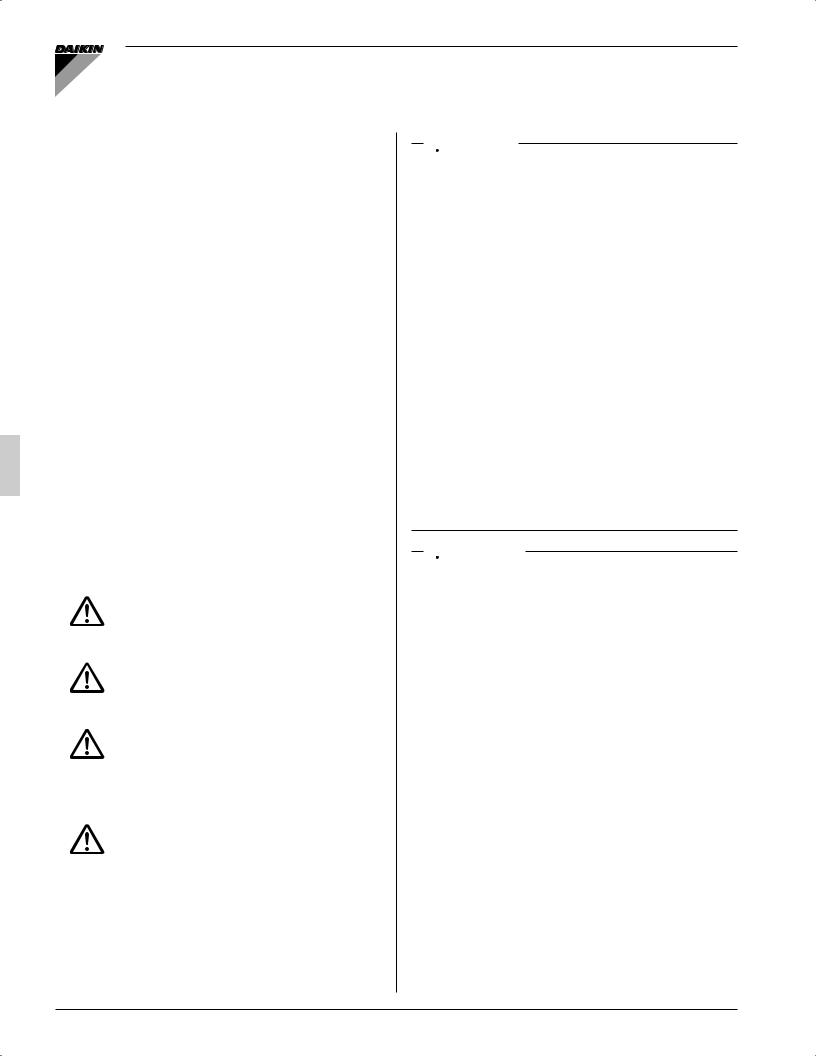
SPLIT SYSTEM Air Conditioners |
Installation manual |
|
|
|
CONTENTS |
|
1. |
SAFETY CONSIDERATIONS........................................ |
1 |
2. |
BEFORE INSTALLATION............................................... |
3 |
3. |
SELECTING INSTALLATION SITE................................ |
4 |
4. |
INDOOR UNIT INSTALLATION...................................... |
5 |
5. |
REFRIGERANT PIPING WORK.................................... |
8 |
6. |
DRAIN PIPING WORK................................................... |
9 |
7. |
ELECTRIC WIRING WORK......................................... |
10 |
8. |
WIRING EXAMPLE AND HOW TO SET |
|
|
THE REMOTE CONTROLLER.................................... |
11 |
9. |
FIELD SETTING.......................................................... |
14 |
10. |
TEST OPERATION...................................................... |
15 |
1. SAFETY CONSIDERATIONS
Read these SAFETY CONSIDERATIONS for Installation carefully before installing air conditioning equipment. After completing the installation, make sure that the unit operates properly during the startup operation.
Instruct the customer on how to operate and maintain the unit. Inform customers that they should store this Installation Manual with the Operation Manual for future reference. Always use a licensed installer or contractor to install this product. Improper installation can result in water or refrigerant leakage, electrical shock, fire, or explosion.
Meanings of DANGER, WARNING, CAUTION, and NOTE
Symbols:
DANGER .................Indicates an imminently hazardous situation which, if not
avoided, will result in death or serious injury.
WARNING ..............Indicates a potentially hazardous situation which, if not
avoided, could result in death or serious injury.
CAUTION ................Indicates a potentially hazardous situation which, if not
avoided, may result in minor or moderate injury. It may also be used to alert against unsafe practices.
NOTE Indicates situations that may result in equipment or prop-
erty damage accidents only.
 DANGER
DANGER
•• Refrigerant gas is heavier than air and replaces oxygen. A massive leak can lead to oxygen depletion, especially in basements, and an asphyxiation hazard could occur leading to serious injury or death.
•• Do not ground units to water pipes, gas pipes, telephone wires, or lightning rods as incomplete grounding can cause a severe shock hazard resulting in severe injury or death. Additionally, grounding to gas pipes could cause a gas leak and potential explosion causing severe injury or death.
•• If refrigerant gas leaks during installation, ventilate the area immediately. Refrigerant gas may produce toxic gas if it comes in contact with fire. Exposure to this gas could cause severe injury or death.
•• After completing the installation work, check that the refrigerant gas does not leak throughout the system.
•• Do not install unit in an area where flammable materials are present due to risk of explosions that can cause serious injury or death.
•• Safely dispose of all packing and transportation materials in accordance with federal/state/local laws or ordinances. Packing materials such as nails and other metal or wood parts, including plastic packing materials used for transportation, may cause injuries or death by suffocation.
 WARNING
WARNING
•• Only qualified personnel must carry out the installation work. Installation must be done in accordance with this installation manual. Improper installation may result in water leakage, electric shock, or fire.
•• When installing the unit in a small room, take measures to keep the refrigerant concentration from exceeding allowable safety limits. Excessive refrigerant leaks, in the event of an accident in a closed ambient space, can lead to oxygen deficiency.
•• Use only specified accessories and parts for installation work. Failure to use specified parts may result in water leakage, electric shocks, fire, or the unit falling.
•• Install the air conditioner on a foundation strong enough that it can withstand the weight of the unit. A foundation of insufficient strength may result in the unit falling and causing injuries.
•• Take into account strong winds, typhoons, or earthquakes when installing. Improper installation may result in the unit falling and causing accidents.
•• Make sure that a separate power supply circuit is provided for this unit and that all electrical work is carried out by qualified personnel according to local, state and national regulations. An insufficient power supply capacity or improper electrical construction may lead to electric shocks or fire.
•• Make sure that all wiring is secured, that specified wires are used, and that no external forces act on the terminal connections or wires. Improper connections or installation may result in fire.
1 |
English |
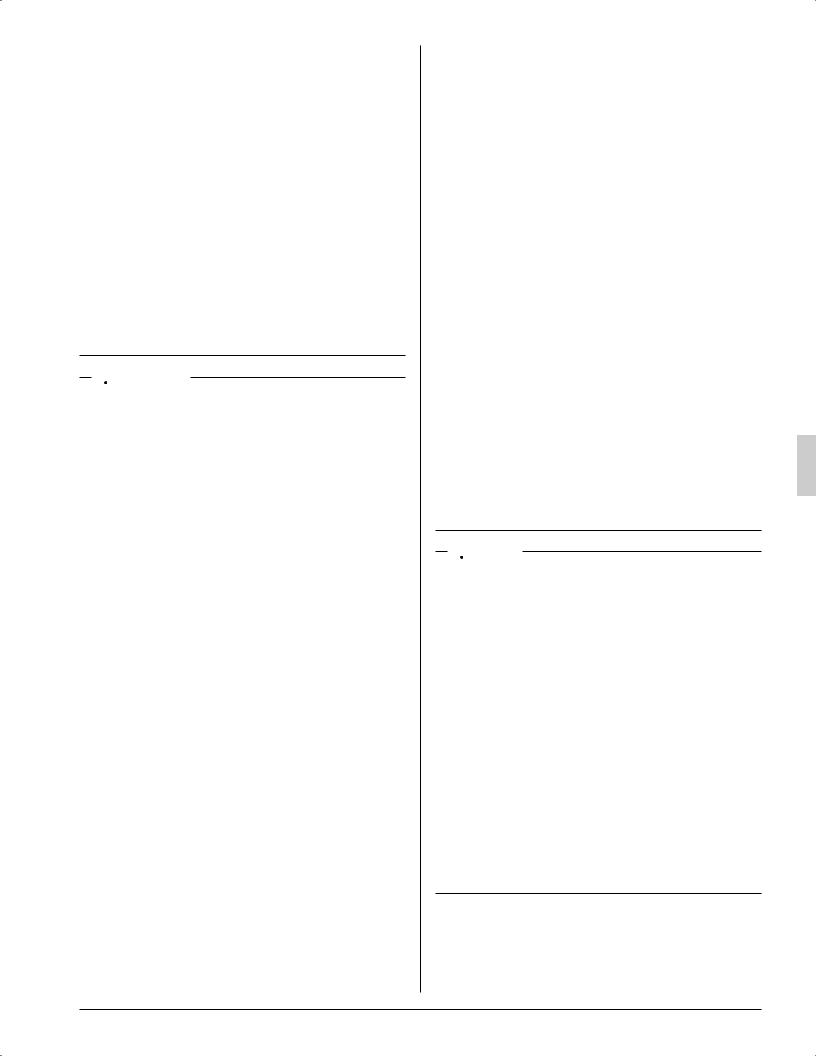
•• When wiring, position the wires so that the control box cover can be securely fastened. Improper positioning of the control box cover may result in electric shocks, fire, or the terminals overheating.
•• Before touching electrical parts, turn off the unit.
•• This equipment can be installed with a Ground-Fault
Circuit Interrupter (GFCI). Although this is a recognized measure for additional protection, with the grounding system in North America, a dedicated GFCI is not necessary.
•• When installing or relocating the system, keep the refrigerant circuit free from substances other than the specified refrigerant (R410A) such as air. Any presence of air or other foreign substance in the refrigerant circuit can cause an abnormal pressure rise or rupture, resulting in injury.
•• Do not change the setting of the protection devices. If the pressure switch, thermal switch, or other protection device is shorted and operated forcibly, or parts other than those specified by Daikin are used, fire or explosion may occur.
 CAUTION
CAUTION
•• Do not touch the switch with wet fingers.Touching a switch with wet fingers can cause electric shock.
•• Do not allow children to play on or around the unit to prevent injury.
•• Do not touch the refrigerant pipes during and immediately after operation as the refrigerant pipes may be hot or cold, depending on the condition of the refrigerant flowing through the refrigerant piping, compressor, and other refrigerant cycle parts.Your hands may suffer burns or frostbite if you touch the refrigerant pipes. To avoid injury, give the pipes time to return to normal temperature or, if you must touch them, be sure to wear proper gloves.
•• Heat exchanger fins are sharp enough to cut.To avoid injury, wear glove or cover the fins when working around them.
•• Install drain piping to proper drainage. Improper drain piping may result in water leakage and property damage.
•• Insulate piping to prevent condensation.
•• Be careful when transporting the product.
•• Do not turn off the power supply immediately after stopping operation. Always wait for at least 5 minutes before turning off the power supply. Otherwise, water leakage may occur.
•• Do not use a charging cylinder. Using a charging cylinder may cause the refrigerant to deteriorate.
•• Refrigerant R410A in the system must be kept clean, dry, and tight.
(a)Clean and Dry -- Foreign materials (including mineral oils such as SUNISO oil or moisture) should be prevented from getting into the system.
(b)Tight -- R410A does not contain any chlorine, does not destroy the ozone layer, and does not reduce the earth’s protection again harmful ultraviolet radiation.
R410A can contribute to the greenhouse effect if it is released. Therefore take proper measures to check for the tightness of the refrigerant piping installation. Read the chapter REFRIGERANT PIPING WORK and follow the procedures.
•• Since R410A is a blend, the required additional refrigerant must be charged in its liquid state. If the refrigerant is charged in a gaseous state, its composition can change and the system will not work properly.
•• The indoor unit is for R410A. See the catalog for indoor models that can be connected. Normal operation is not possible when connected to other units.
•• Handheld remote controller transmitting distance can be shorter than expected in rooms with electronic fluorescent lamps (inverter or rapid start types). Install the indoor unit far away from fluorescent lamps as much as possible.
•• Indoor units are for indoor installation only. Outdoor units can be installed either outdoors or indoors.
•• Do not install the air conditioner in the following locations:
(a)Where a mineral oil mist or oil spray or vapor is produced, for example, in a kitchen.
Plastic parts may deteriorate and fall off or result in water leakage.
(b)Where corrosive gas, such as sulfurous acid gas, is produced.
Corroding copper pipes or soldered parts may result in refrigerant leakage.
(c)Near machinery emitting electromagnetic waves. Electromagnetic waves may disturb the operation of the control system and cause the unit to malfunction.
(d)Where flammable gas may leak, where there is carbon fiber, or ignitable dust suspension in the air, or where volatile flammables such as thinner or gasoline are handled. Operating the unit in such conditions can cause a fire.
 NOTE
NOTE
•• Install the power supply and control wires for the indoor and outdoor units at least 3.5 feet (1.0 m) away from televisions or radios to prevent image interference or noise. Depending on the radio waves, a distance of 3.5 feet (1.0 m) may not be sufficient to eliminate the noise.
•• Dismantling the unit, treatment of the refrigerant, oil and additional parts must be done in accordance with the relevant local, state, and national regulations.
•• Do not use the following tools that are used with conventional refrigerants: gauge manifold, charge hose, gas leak detector, reverse flow check valve, refrigerant charge base, vacuum gauge, or refrigerant recovery equipment.
•• If the conventional refrigerant and refrigerator oil are mixed in R410A, the refrigerant may deteriorate.
•• This air conditioner is an appliance that should not be accessible to the general public.
•• As design pressure is 478 psi (3.3 MPa), the wall thickness of field-installed pipes should be selected in accordance with the relevant local, state, and national regulations.
English |
2 |
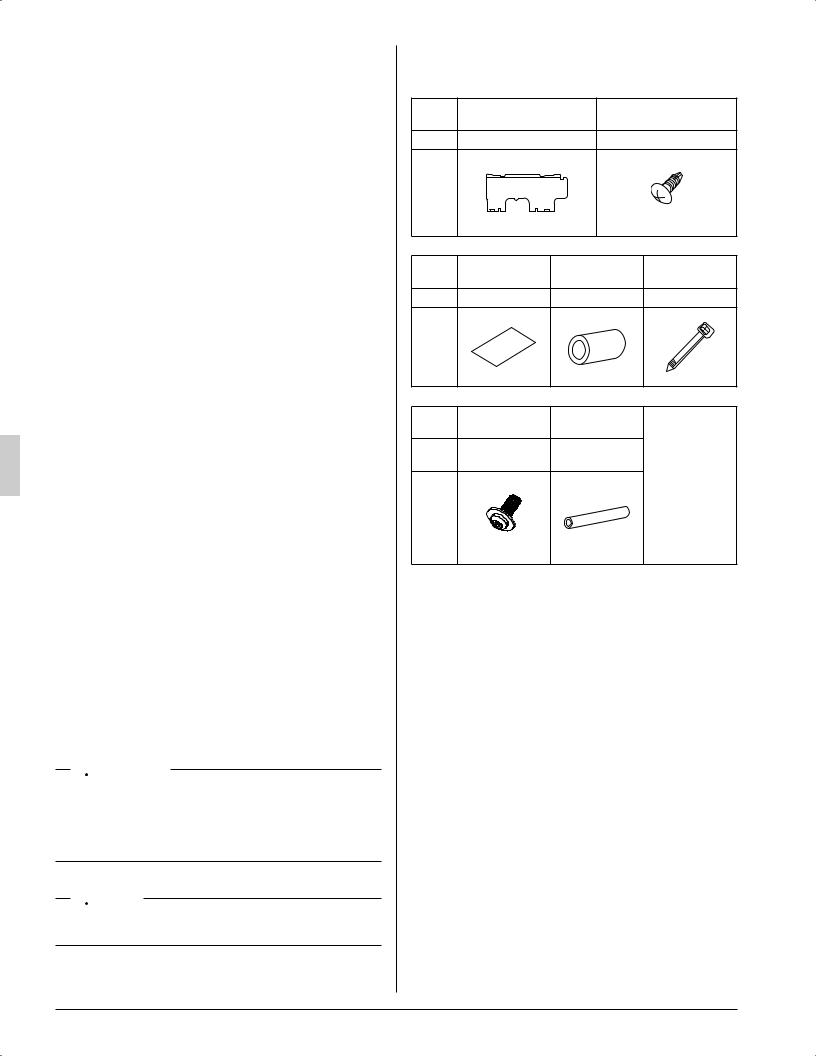
2. BEFORE INSTALLATION
•• When unpacking the unit or moving the unit after unpacked, be sure to lift it by the four hanger brackets. Avoid putting any pressure on other parts-hori- zontal flaps, the refrigerant piping, drain piping, and other resin parts.
•• Be sure to remove a cushion (corrugated paper) located between the heat exchanger and the right air filter.
•• Be sure to check the type of R410A refrigerant to be used before installing the unit. (Using an incorrect refrigerant will prevent normal operation of the unit.)
•• The accessories needed for installation must be retained in your custody until the installation work is completed. Do not discard them!
•• Decide upon a line of transport.
•• Leave the unit inside its packaging while moving, until reaching the installation site. Where unpacking is unavoidable, use a sling of soft material or protective plates together with a rope when lifting, to avoid damage or scratches to the unit.
•• For the installation of an outdoor unit, refer to the installation manual attached to the outdoor unit.
•• When using the wireless remote controller, refer to the installation manual attached to the wireless remote controller.
•• Do not install or operate the unit in rooms mentioned below.
•• Laden with mineral oil, or filled with oil vapor or spray like in kitchens. (Plastic parts may deteriorate which could eventually cause the unit to fall out of place, or could lead to leaks.)
•• Where corrosive gas like sulfurous gas exists.
(Copper tubing and brazed spots may corrode which could eventually lead to refrigerant leaks.)
•• Where exposed to combustible gases and where volatile flammable gas like thinner or gasoline is used.
(Gas in the vicinity of the unit could ignite.)
•• Where machines can generate electromagnetic waves. (Control system may malfunction.)
•• Where the air contains high levels of salt such as that near the ocean and where voltage fluctuates greatly such as that in factories, vehicles or vessels.
•• This unit, both indoor and outdoor, is suitable for installation in a commercial and light industrial environment. If installed as a household appliance it could cause electromagnetic interference.
 WARNING
WARNING
•• Entrust installation to the place of purchase or an authorized serviceman. Improper installation could lead to leaks and, in worse cases, electric shock of fire.
•• Use of unspecified parts could lead to the unit falling, leaks and, in worse cases, electric shock or fire.
 NOTE
NOTE
•• Be sure to read this manual before installing the indoor unit.
2-1 ACCESSORIES
Check if the following accessories are attached to the indoor unit.
Name |
(1) Installation panel |
(2) Attachment screw |
|||
|
for the installation panel |
||||
|
|
|
|
||
Quantity |
1 pc. |
|
|
|
9 pcs. |
Shape |
|
|
|
|
|
|
|
|
|
|
M4 × 25L |
Name |
(3) Paper pattern |
(4) Insulating |
(5) Clamp |
||
for installation |
|
tape |
|
||
|
|
|
|
||
Quantity |
1 pc. |
|
1 pc. |
|
1 large 4 small |
Shape |
|
|
|
|
|
Name |
(6) Securing |
(7) Insulating |
|
screw |
tube |
||
|
|
|
1 long |
(Other) |
|
Quantity |
2 pcs. |
•• Operation |
||
1 short |
||||
|
|
manual |
||
|
|
|
||
|
|
|
•• Installation |
|
|
|
|
manual |
|
Shape |
|
|
•• Warranty |
|
|
|
|
card |
|
|
M4 × 12L |
|
|
2-2 OPTIONAL ACCESSORIES
Remote controller |
Model |
|
|
Wired type |
BRC1E73 |
|
|
Wireless type |
BRC7E818 |
|
|
3 |
English |
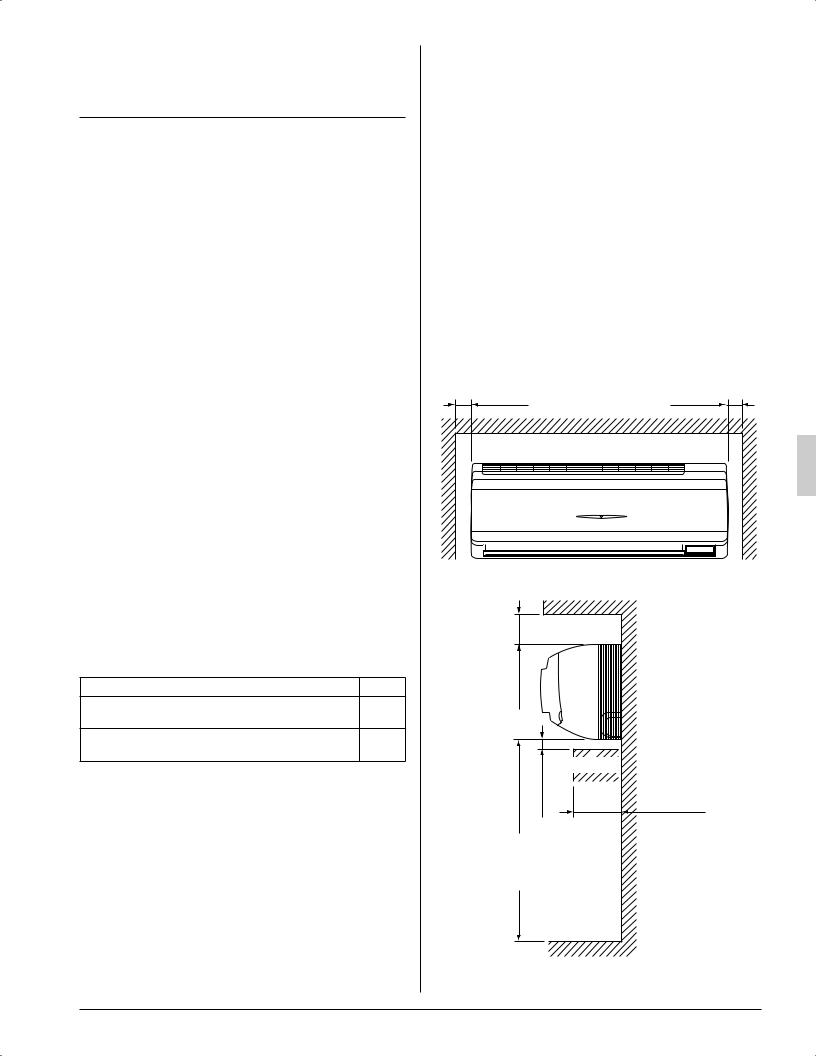
FOR THE FOLLOWING ITEMS, TAKE SPECIAL CARE DURING CONSTRUCTION AND CHECK AFTER INSTALLATION IS FINISHED.
(1) Items to be checked after completion of work
Items to be checked |
If not properly done, |
Check |
|
what is likely to occur |
|||
|
|
||
|
|
|
|
Are the indoor and outdoor |
The units may drop, vibrate |
|
|
units fixed firmly? |
or make noise. |
|
|
|
|
|
|
Is the gas leak test fin- |
It may result in insufficient |
|
|
ished? |
cooling or heating. |
|
|
|
|
|
|
Is the unit fully insulated? |
Condensate water may |
|
|
drip. |
|
||
|
|
||
|
|
|
|
Does drainage flow |
Condensate water may |
|
|
smoothly? |
drip. |
|
|
|
|
|
|
Does the power supply |
The unit may malfunction |
|
|
voltage correspond to that |
or the components may |
|
|
shown on the name plate? |
burn out. |
|
|
|
|
|
|
Are wiring and piping |
The unit may malfunction |
|
|
or the components may |
|
||
correct? |
|
||
burn out. |
|
||
|
|
||
|
|
|
|
Is the unit safely |
It may be dangerous at |
|
|
grounded? |
electric leakage. |
|
|
|
|
|
|
Is wiring size according to |
The unit may malfunction |
|
|
or the components burn |
|
||
specifications? |
|
||
out. |
|
||
|
|
||
|
|
|
|
Is something blocking the |
It may result in insufficient |
|
|
air outlet or inlet of either |
|
||
cooling. |
|
||
the indoor or outdoor unit? |
|
||
|
|
|
|
Are refrigerant piping |
|
|
|
length and additional |
The refrigerant charge in |
|
|
refrigerant charge noted |
the system is not clear. |
|
|
down? |
|
|
|
|
|
|
|
Did you check that no |
|
|
|
wiring connection screws |
Electric shock or fire. |
|
|
were loose? |
|
|
|
|
|
|
Also review the “SAFETY CONSIDERATIONS”
(2) Items to be checked at delivery
Items to be checked |
Check |
Did you explain how to operate the unit while showing the operation manual to your customer?
Did you give the operation manual over to your customer?
2-3 NOTE TO THE INSTALLER
Be sure to instruct customers how to properly operate the unit (especially cleaning filters, operating different functions, and adjusting the temperature) by having them carry out operations themselves while looking at the manual.
3. SELECTING INSTALLATION SITE
(1)Select an installation site where the following conditions are fulfilled and has the customer’s approval.
•• Where there will be no possible dripping of water from the refrigerant pipe, drain pipe, etc., in the area between the unit and ceiling, and in the attic just above the unit.
•• Where the wall is strong enough to bear the indoor unit weight.
•• Where sufficient clearance for installation and maintenance can be ensured.
(Refer to Fig. 1 and Fig. 2)
•• Where optimum air distribution can be ensured.
•• Where nothing blocks the air passage.
•• Where condensate can be properly drained.
•• Where the wall is not significantly tilted.
•• Where piping between indoor and outdoor unit is possible within the allowable limit.
(Refer to the installation manual of the outdoor unit.)
•• Install the indoor and outdoor units power supply wiring and connecting wires at least 3.5 ft. (1 m) away from televisions or radios in order to prevent image interference or noise.
(Depending on the radio waves, a distance of 3.5 ft. (1 m) may not be sufficient enough to eliminate the noise.)
•• Where the cool (warm) air reaches all across the room.
[ Space required for installation [in. (mm)] ]
≥ 2 (50) |
≥ 2 (50) |
Fig. 1
≥ 3-1/2 (90) |
|
≥ 1-1/4 (30) |
Obstruction |
|
|
≥ 100 (2500) |
|
(from floor) |
|
For installation |
|
in high places. |
|
|
Floor |
≤ 4-3/4 (120)
Fig. 2
English |
4 |
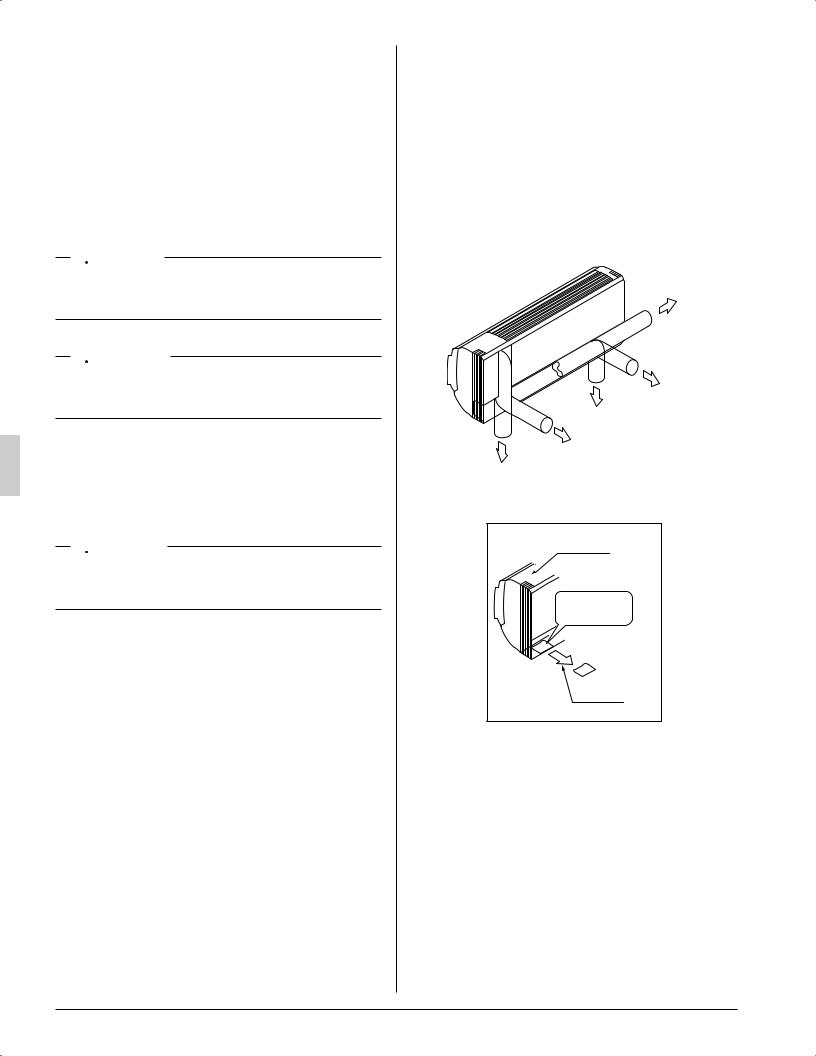
(2)Consider whether the place where the unit will be installed can support the full weight of the unit, and reinforce it with boards and beams, etc. if needed before proceeding with the installation. Also, reinforce the area to prevent vibration and noise before installing.
(The installation pitch can be found on the paper pattern for installation (3), so refer to it when considering the necessity for reinforcing the location.)
(3)The indoor unit may not be directly installed on the wall. Use the attached installation panel (1) before installing the unit.
 DANGER
DANGER
•• Do not install unit in an area where flammable materials are present due to risk of explosion resulting in serious injury or death.
 WARNING
WARNING
•• If the supporting structural members are not strong enough to take the unit’s weight, the unit could fall out of place and cause serious injury.
4. INDOOR UNIT INSTALLATION
•• Use only accessories and parts which are of the designated specification when installing.
 CAUTION
CAUTION
•• Install so that the unit does not tilt to either side or forward.
•• Do not hold the unit by the horizontal flaps when lifting it. (This may damage the horizontal flaps.)
(1) Open the piping through-hole.
•• The refrigerant pipe and drain pipe can be routed out in one of 5 directions: left, bottom-left, back-left, bottom-right, and back-right. (Refer to Fig. 3)
•• Using the paper pattern for installation (3), choose where to route the piping out of the unit, and drill a through-hole (f3-1/8” (f80)) in the wall.
Open the hole so that there is a downward slope for the drain piping. (See “6. DRAIN PIPING WORK”)
(2)Attach the installation panel (1) to the wall.
(a)Check the location for the hole using the included paper pattern for installation (3).
•• Choose a location so that there is at least a 3-5/8” (90 mm) gap between the ceiling and the main unit.
(b)Temporarily attach the installation panel (1) at the temporary-securing position on the paper pattern for installation (3) and use a level to make sure the drain hose is either level or tilted slightly downward.
(c)Secure the installation panel (1) to the wall using either screws or bolts.
•• If using the attachment screws for the installation panel (2), attach using at least 4 screws on either side, for a total of 9 screws of the recommended installation cleat position on the included paper pattern for installation (3).
•• If using bolts, attach using a M8 - M10 bolt or equivalent (for a total of 2 bolts) on either side.
•• If dealing with concrete, use commercially available foundation bolts (M8 - M10 or equivalent).
(3)If using the left, bottom-left, or bottom-right positions for the piping, cut out the through-hole for the piping in the front grille. (Refer to Fig. 4)
Left pipe
Back-left pipe
Bottom-left pipe
Back-right pipe
Bottom-right pipe
Fig. 3
Front grille |
Cut out along |
the groove. |
Cut away |
Fig. 4
5 |
English |
